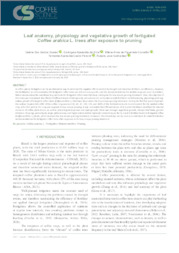Leaf anatomy, physiology and vegetative growth of fertigated Coffee arabica L. trees after exposure to pruning.
Leaf anatomy, physiology and vegetative growth of fertigated Coffee arabica L. trees after exposure to pruning.
Author(s): SOARES, D. dos S.; SILVA, E. A. da; CARVALHO, M. A. de F.; PEREIRA, F. A. C.; GUIMARÃES, R. J.
Summary: In coffee plants, fertigation can be an alternative way to minimize the negative effects exerted by drought and maximize fertilizer use efficiency. However, the fertilization recommendations for fertigated coffee trees are still not very specific, and the recommendations for rainfed crops are used. In addition, little is known about the nutritional requirements for fertigated coffee trees that have undergone the low recepa pruning treatment. Thus, the objective of this study was to evaluate the effects of different levels of nitrogen (N), phosphorus (P), and potassium (K) fertilizers on leaf anatomy, physiology, and vegetative growth of fertigated coffee trees (Coffea arabica L.) that have been under the low recepa pruning treatment. During the first five years of growth, the cultivar Topázio MG-1190 of the coffee crop received 10, 40, 70, 100, 130, and 160% of the fertilization levels recommended for the rainfed coffee crop. After this period, the crop was exposed to low recepa pruning. It was concluded that different doses of N, P, and K fertilizers modified the internal structure of coffee plant leaves, as well as physiological responses and plant growth; there was stronger vegetative growth, sharper leaf blade, greater thickness of spongy parenchyma, larger phloem area, and higher xylem relative hydraulic conductivity as the N, P, and K fertilizer levels in fertigated coffee (Coffea arabica L.) plants, which received the low recepa pruning treatment, increased. This knowledge can be used as a solid basis for main fertilization recommendations for fertigated coffee trees after exposure to the low recepa pruning treatment.
Publication year: 2021
Types of publication: Journal article
Unit: Embrapa Coffee
Observation
Some of Embrapa's publications are published as ePub files. To read them, use or download one of the following free software options to your computer or mobile device. Android: Google Play Books; IOS: iBooks; Windows and Linux: Calibre.
Access other publications
Access the Agricultural Research Database (BDPA) to consult Embrapa's full library collection and records.
Visit Embrapa Bookstore to purchase books and other publications sold by Embrapa.

